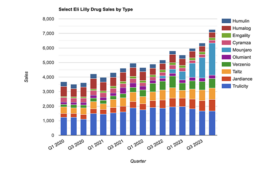
The biotechnology company RXi Pharmaceuticals was built on the pioneering discovery of RNA interference (RNAi).
RXi has developed a robust RNAi therapeutic platform—including its self-delivering RNA (sd-rxRNA) compounds, which have the ability to selectively block the expression of any target in the genome.
Although RXi has its own clinical programs in dermatology, ophthalmology and cell-based cancer immunotherapy, President and CEO Dr. Geert Cauwenbergh believes sd-rxRNA can be used across a broad spectrum of therapeutic areas. Drug Discovery & Development recently spoke with him about the history of RNAi’s, how they work, and how close they are to becoming a reality for patients.
DD&D: Can you provide a history of RNAi technology?
Geert Cauwenbergh: In 2006, Craig Mello and Andrew Fire were awarded a Nobel Prize for their co-discovery of RNAi, which is considered one of the greatest scientific breakthroughs since the discovery of DNA.
It is now known that the RNAi mechanism regulates gene expression, thereby controlling protein production. If researchers target a specific protein that is being made, and in the case of a disease a bad protein, there is the potential to treat the disease by reducing the amount of the protein using RNAi.
Shortly after the discovery in 1998, new companies emerged to harness this naturally occurring mechanism to combat certain diseases. It was soon thereafter that they ran into a roadblock: delivery of the RNAi compounds into cells. These companies then spent many years researching how to use different delivery vehicles for their therapeutic approaches.
It was in 2006 that Dr. Mello founded a company called RXi Pharmaceuticals and the company got to work on the delivery aspect. For the next several years, a team of scientists at RXi worked on how to deliver RNAi compounds into cells without the need for a delivery vehicle. This research resulted in the formation of a novel technology platform known as “self-delivering RNAi” or sd-rxRNA.
DD&D: How does RXi’s technology work?
GC: sd-rxRNA is a single chemically modified compound with delivery and therapeutic properties built directly into the compound itself. The compound is asymmetrical with a phosphorothioate backbone and contains chemical modifications that provide for efficient cellular uptake and gene silencing. They are potent, stable and specific, and demonstrated to be safe and active in a clinical setting.
DD&D: How is RXi’s technology different from its competitors?
GC: RXi’s novel sd-rxRNA technology differs from natural and most synthetic RNA interference (RNAi) molecules in that they are chemically modified to allow for efficient internalization of the compounds by cells and silencing of the targeted genes. Importantly, unlike other naked siRNA compounds, delivery of sd-rxRNAs are not limited to a specific cell type. For local delivery and ex vivo cell-based therapeutic applications, our compounds do not require delivery vehicles. This is a major advantage, since delivery vehicles can have related toxicity that affect cell viability. We have shown that our sd-rxRNA has nearly 100 percent transfection efficiency with high cell viability in numerous cell types.
DD&D: Where are RNAi’s in the drug approval pipeline?
GC: Today, there are no approved RNAi therapeutics. However, there are a few ongoing advanced clinical trials being done at other companies that may reach approval within the next one to two years. RXi has earlier-stage trials ongoing, a Phase 2 in dermatology and Phase 1/2 in ophthalmology. This past year, we also initiated a development program in cell therapy to treat cancer and have made considerable progress to date to show how our technology can be broadly applicable in an immuno-oncology setting.
DD&D: Can you talk more about RXi’s cancer program?
GC: Immunotherapy of cancer has become increasingly important in medicine for all clinical practice over the recent decade. By activating the patient’s own immune system, immunotherapy treatments have shown remarkable promise in extending the lifespan of previously untreatable cancer patients. Two approaches to immunotherapy—immune checkpoint inhibition and immune cell-based therapies—are particularly promising and advanced in the clinic.
Industry-leading programs developed by other companies with CAR T-cells received FDA approval this year. Adoptive cell transfer involves isolation of immune cells from patients’ blood or tumor samples, their treatment ex vivo to improve their ability to kill tumor cells and reinfusion back to patients.
CAR T-cells have been extremely effective in the treatment of hematological cancers, such as some lymphomas. But they have so far been much less effective for solid tumors. One of the reasons for that is the immuno-suppressive tumor microenvironment in solid tumors.
These days, companies involved in adoptive cell transfer try to address this problem by blocking immune checkpoints with monoclonal antibodies, or knocking out checkpoints from therapeutic cells by gene editing techniques such as CRISPR.
RXi is taking a different approach to enabling therapeutic cells to destroy solid tumors. Our sd-rxRNA compounds are highly efficient in transfecting immune cells ex-vivo and silencing immune checkpoints. Unlike monoclonal antibodies, sd-rxRNA can be used in combination to modulate multiple checkpoints in a single therapeutic treatment. Unlike gene editing, we are not introducing permanent modifications to the cell genome, and thus avoid potential long-term issues.
DDD: Can you discuss any current studies?
GC: To date, we have achieved exciting results with our anti-PD-1 sd-rxRNA. We have shown that tumor-infiltrating lymphocytes isolated from melanoma of a patient, and transfected with an sd-rxRNA PD-1 inhibitor, resulted in a major boost in tumor cell-killing activity in vitro as compared to an anti-PD-1 antibody.
In addition, we have demonstrated a statistically significant reduction in the growth rate of human ovarian tumors at one month, in a mouse model, following a single treatment with a mesothelin-targeting CAR T-cell that has been transfected with our sd-rxRNA PD-1 inhibitor, as compared to the untreated control tumors. In that same study, we established that the transfected CAR T-cells still showed down-regulation of PD-1 at one month when isolated from the mouse tumor. Today, we have identified our sd-rxRNA compounds against six different checkpoint targets and filed IP to protect our development assets.
Using these compounds, we have demonstrated that both extracellular, as well as intracellular, checkpoints can be down-regulated, which is a major benefit over checkpoint-inhibiting antibodies, considering antibodies can only target extracellular proteins. Moreover, we learned that the same cell batch could be transfected by at least four different checkpoint inhibitors simultaneously, as effectively as individually. Also, a major benefit compared to antibodies for which combination therapy is not self-evident.
Most recently, RXi selected two sd-rxRNA compounds from its immuno-oncology pipeline for preclinical development. For oncology treatments based on adoptive cell transfer (ACT), compounds RXI-762 and RXI-804 suppress the expression of immune checkpoint proteins PD-1 and TIGIT respectively, which can result in an improved efficacy to the targeted tumors. This decision triggered the selection of a manufacturing facility to initiate production of cGMP-grade material, initially for the first of these two compounds (RXI-762). The latter also supports moving RXI-762 into clinical development as early as 2018 as part of an ACT therapy. sd-rxRNA offers unprecedented flexibility in targeting immunosuppressive pathways with the potential to modulate multiple checkpoint genes in a single therapeutic treatment.
In addition to CAR T work, we are also studying RXI-762 and RXI-804 in other types of therapeutic cells through academic collaborations. This includes our continued research that underlies potential applications including sd-rxRNA stem cell transplants for the treatment of hematological cancers, TILS and solid tumors.
DD&D: This same approach reduces scarring in dermatological diseases?
GC: Yes, our first lead clinical compound, RXI-109, is an sd-rxRNA that targets connective tissue growth factor (CTGF), a key regulator in fibrosis. RXI-109 is in development to reduce fibrosis in the skin and eye and is currently being evaluated in a Phase 2 study in dermatology and a Phase 1/2 study in ophthalmology. In the dermatology study 1402, RXI-109 is being evaluated for the management of hypertrophic scars after scar revision surgery. In these trials, we have shown that RXI-109 was safe and well-tolerated, with adverse events being typical to the healing process following scar revision surgery and intradermal injections. These included mild-to-moderate redness, pain and tenderness. There have been no RXI-109 related serious adverse events.
We have also reported preliminary results indicating that the use of RXI-109 after scar revision surgery had a visible, beneficial effect on the suppression of hypertrophic scarring at three months following revision surgery. A readout on this program is expected before the end of this year.
DD&D: Are the intraocular injections in clinical trials?
GC: In our ophthalmology study 1501, RXI-109 is being evaluated for safety and tolerability following intraocular injections in patients with advanced wet age-related macular degeneration and associated retinal scarring.
Currently, there is no effective way to prevent the formation or progression of retinal scars that may occur as a consequence of several devastating ocular diseases. In advanced neovascular or “wet” age-related macular degeneration, our first area of study, retinal scarring can result in continued vision loss. RXI-109 has the potential to fill this unmet medical need by reducing this continuing damage to the retina and, in doing so, helping to preserve vision in these individuals for a longer period of time.
Wet AMD is currently treated with anti-VEGF therapies to block vascular endothelial growth factor (VEGF) from causing blood vessel leakiness and the consequential damage to the retina. However, as the disease progresses, many advanced patients also experience retinal scarring, which leads to further vision loss. Our ultimate goal is to reduce the scarring that is secondary to advanced wet AMD and in doing so, preserve vision for a longer period time.
Today, there are no approved therapeutics in the U.S. for the treatment and prevention of subretinal fibrosis. Such a therapy could benefit patients with the advanced wet AMD as well as those with other ocular indications with a scarring component such as proliferative vitreoretinopathy (PVR) and proliferative diabetic retinopathy (PDR).
DD&D: Any other future potential areas you are researching?
GC: Our technology platform is broadly applicable to many therapeutic areas. As a small company, we cannot be active in all these areas. We have provided a license to our technology platform to a few smaller companies, such as TheraNeuropharma, for the development of ALS therapeutics. Also, we are collaborating with BioAxone for the development of sd-rxRNA compounds targeting PTEN to treat spinal cord injury as part of a recent grant award. We are actively speaking with small and large pharmaceutical companies to collaborate and partner our platform in a number of therapeutic areas.
DD&D: When do you think this therapy will be available to patients?
CG: Over the next five to 10 years, we would expect to see a dramatic revolution not only in the way we deal with cancer but also autoimmune diseases. You can imagine the benefits of our sd-rxRNA technology and the ability to affect the production of targeted proteins both intracellular and extracellular; the potential is limitless. We are only limited by our financial runway. It will require substantial investment to advance research and development so that we can deliver the benefits of RNAi-based therapeutics to patients.
Filed Under: Drug Discovery




